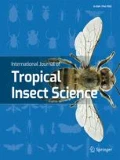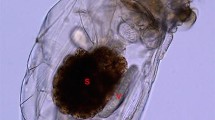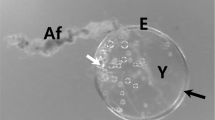Abstract
Scanning electron microscopic examination of the egg shell and associated structures of Eocanthecona furcellata (Wolff.) (Hemiptera: Pentatomidae) reveals a distinct pattern of structural elements, viz. microsculpture of the chorion, pseudoperculum, egg burster and aeromicropylar processes. The egg shell has a highly decorated chorion with a structural difference at both the anterior and posterior ends. A reticulate type of microsculpture with varying sizes of spine-like projections measures 4.02 ± 0.06 to 8.12 ± 0.05 μm and forms an asteroid-like shape at the anterior pole, while the surface at the posterior end has elongated striations over the chorion measuring 72.00 ± 0.074 μm. The pseudoperculum of the egg shell is a circular lid measuring 518 ± 11.43 μn in diameter. During hatching the line of rupture follows the micropylar ring, and this sometimes extends beyond the ring of micropylar processes. An inverted T-shaped black egg burster measures 202 ± 4.63 μm in length, is well developed and can be seen prior to hatching within a thin and transparent egg shell. It is a median sclerotised part of embryonic cuticle. The aeromicropylar processes are situated at the anterior pole of the barrel-shaped eggs. There are 26–28 aeromicropylar processes arranged in a circle at almost equidistance and each micropylar process is slightly curved opposite to the pseudoperculum lid with a bulbous end at the apex. The aeromicropylar processes are 25.40 ± 0.083 μm in length and 3.02 ± 0.07 μm in width. Each micropylar process has a central canal for the passage of sperm whereas the rest of its body is porous, and allows respiratory interchange.
Résumé
L’observation au microscope électronique à balayage de l’enveloppe et des structures associées de l’oeuf de Eocanthecona furcellata (Wolff.) (Hemiptera: Pentatomidae) révèle une différence de motif des éléments structuraux, à savoir des microsculptures du chorion, un opercule, une languette d’éclosion et des aéropyles. L’enveloppe de l’oeuf a un chorion richement décoré avec une différence structurale aux deux extrémités antérieure et postérieure. Une microsculpture de type réticulé avec des projections en forme d’épine de tailles variables qui mesurent 4,02 ± 0,06 à 8,12 ± 0,05 (im et constituent une sorte d’astéroïde au pôle antérieure, alors que la surface de l’extrémité postérieure a des striations allongées sur le chorion mesurant 72,00 ± 0,074 μm. L’opercule est un couvercle circulaire mesurant 518 ± 11,43 μm de diamètre. Pendant l’éclosion la ligne de moindre résistance suit l’anneau micropilaire, et s’étend parfois au delà. Un languette d’éclosion en forme de T inversé mesurant 202 ± 4,63 (im de long, est bien développée et peut être vu avant l’éclosion à l’intérieur d’une enveloppe de l’oeuf fine et transparente. C’est une partie sclérotisée médiane de la cuticule embryonnaire. Les aéropyles sont situés au pôle antérieur des oeufs qui a la forme d’un tonneau. Il y a 26–28 aéropyles disposés en cercle à quasi équidistance et chaque micropyle est légèrement recourbé à l’opposé de l’opercule avec une extrémité bulbeuse à l’apex. Les aéropyles ont 25,40 ± 0,83 μm de long et 3,02 ± 0,07 μm de large. Chaque micropyle a un canal central pour le passage du sperme alors que le reste de son corps est poreux, et permet les échanges respiratoires.
Similar content being viewed by others
References
Butler E. A. (1923) A Biology of the British Hemiptera-Heteroptera. London, viii + 682 pp.
Cobben R. H. (1965) Das aero-mikropylare system der Homoptereneier und evolutions-trends bei Zikadeneiern (Horn., Auchenorhyncha). Tool. Beitr. 11, 13–69.
Cobben R. H. (1968) Evolutionary Trends in Heteroptera Part 1. Eggs, Architecture of the Shell, Gross Embryology and Eclosion. CTA, Wageningen, Netherlands. 459 pp.
Esselbaugh C. O. (1946) A study of the eggs of the Pentatomidae (Hemiptera). Ann. Entomol. Soc. Am. 34, 667–691.
Gross J. (1901) Untersuchungen uber das ovarium der Hemiptera, Zugleich ein Beitrage zur Amitosenfrage. Wiss. Zool. 69, 139–201.
Gross J. (1903) Untersuchungen uben die Hostologie des Insectenovariums. Zool. Jahrb. 18, 72–176.
Harris M. (1766) (cited in Javehery, 1994.) The Aurelian or Natural History of English Insects. London.
Hinton H. E. (1981) Biology of Insect Eggs. Oxford Pergamon Press, New York, NY. 3 Vols, 1125 pp.
Javahery M. (1968) The egg parasite complex of British Pentatomoidea (Hemiptera): Taxonomy of Telenominae (Hymenoptera: Scelionidae). Trans. R. Entomol. Soc. bond. 120, 417–436.
Javahery M. (1994) Development of eggs in some true bugs (Hemiptera-Heteroptera). Part I. Pentatomoidea. Can. Entomol. 126, 401–433.
Kumar V., Babu A. M., Kariappa B. K., Jayaswal K. P., Katiyar R. L. and Datta R. K. (1999) Surface ultrastructure of the egg chorion of Spilarctia obliqua Walker (Lepidoptera Arctiidae). Redia 82, 137–143.
Kumar V., Morison M. N., Rajadaurai S., Babu A. M., Thiagarajan V. and Datta R. K. (2001) Studies on the biology and predatory behaviour of Eocanthecona furcellata (Wolff.) predating on Spilarctia obliqua (Wlk.) in mulberry plantation. Int. J. Indust. Entomol. 2, 173–180.
Lockwood J. A. and Story R. N. (1986) Embryonic orientation in pentatomids: Its mechanism and function in southern green stink bug (Hemiptera: Pentatomidae). Ann. Entomol. Soc. Am. 79, 963–970.
McPherson J. E. (1982) The Pentatomoidea (Hemiptera) of Northeastern North America with Emphasis on the fauna of Illinois. Southern Illinois University Press, Carbondale, IL. 240 pp.
Margaritis L. H. (1985) Structure and physiology of the egg shell, pp. 153–230. In Comprehensive Insect Physiology, Biochemistry and Pharmacology (Edited by G. A. Kerkut and L. I. Gilbert). Pergamon Press, Oxford.
Puchkova L. V. (1959) The eggs of true bugs (Hemiptera: Heteroptera). V. Pentatomoidea. Rev. Entomol. 38, 634–648.
Puchkova L. V. (1961) The eggs of Hemiptera VI. Pentatomoidea; 2. Pentatomidae and Plataspidae. Rev. Entomol. 40, 131–143.
Puchkova L. V. (1966) The morphology and biology of the egg of the terrestrial bugs (Hemiptera). Horae. Soc. Ent. Un. Sovet. 51, 75–132.
Ren S. (1992) An Iconography of Hemiptera - Heteroptera Eggs in China. Science Pub Co. 118 pp + 80 pls.
Ren S., Guo S. and Zhou X. (1990) Scanning electron microscopic observation on egg-bursters of terrestrialHeteroptera. Acta Entomol. Sin. 33, 189–192.
Richards O. W. and Davies R. G. (1983) Imm’s General Text Book of Entomology. 10th Edn Vol. 2. Classification and Biology. Chapman and Hall, London, New York 1354 pp.
Rosciszewska E. (1991) Ultrastructural and histochemical studies of the egg capsules of Perla marginata (Panzer, 1799) and Dinocras cephalotes (Curtis, 1827). (Plecoptera: Perlidae). Int. J. Insect Morphol. Embryol. 20, 189–203.
Schumacher F. (1917) Eisprenger bei Wanzen aus der Groupe der Pentatomiden (Hemiptera-Heteroptera). Sitz Ber. Ges. Nat. Fre. 91, 438–443.
Socha R. (1988) Altered anteroposterior polarity of micropyle ring formation in the eggs of Pyrrhocoris apterus L. (Heteroptera: Pyrrhocoridae). Int. J. Insect Morphol. Embryol. 17, 135–143.
Southwood T. R. E. (1956) The structure of the eggs of the terrestrial Heteroptera and its relationship to the classification of the group. Trans. R. Ent. Soc. Lond. 108, 163–221.
Author information
Authors and Affiliations
Corresponding author
Rights and permissions
About this article
Cite this article
Kumar, V., Morrison, M.N., Babu, A.M. et al. Egg Shell Architecture of the Stink Bug, Eocanthecona furcellata (Wolff.): Ultrastructure of Micropylar Processes and Egg Burster. Int J Trop Insect Sci 22, 67–73 (2002). https://doi.org/10.1017/S1742758400015071
Accepted:
Published:
Issue Date:
DOI: https://doi.org/10.1017/S1742758400015071




